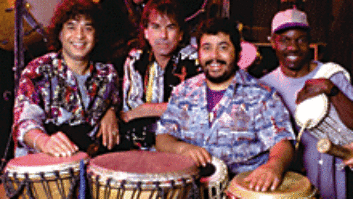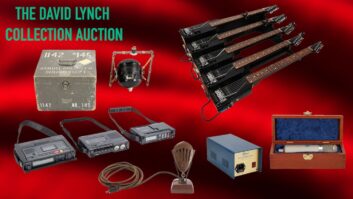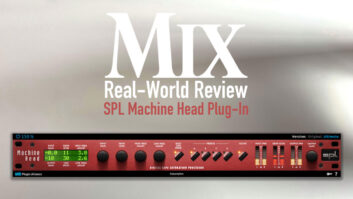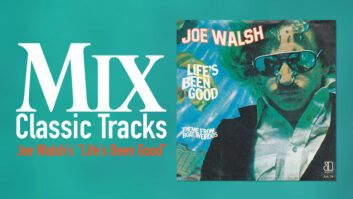It’s a beautiful afternoon in the spring of 2001, and I’m up at percussionist/producer Mickey Hart’s ranch studio in northern Sonoma County, Calif., listening in on tracking sessions for the new Mondo Head CD by Kodo, the extraordinary Japanese drum troupe. Now, if you’ve ever seen Kodo perform — and they tour incessantly, often playing at symphony halls and on university campuses around the world — you know that they are an intensely disciplined and formal group. Their taiko drum pieces unfold with an almost military precision, as they tap and pound large and small drums to create layer upon layer of intricate, often hypnotic patterns. Though their music is not written in the traditional sense, it is learned, and it has an inviolable structure — much of its power derives from the genius of its mapped-out formality. It is, in a sense, classical Japanese drum music.
But you don’t travel to Mickey Hart’s ranch to make by-the-numbers music. Hart’s specialty is spontaneous creation and jamming, as he’s shown on innumerable great percussion records he’s made and/or produced since the mid-’70s. A true world music pioneer, and always a restless spirit, Hart likes to break down barriers between cultures and musicians, mixing players and timbres in unpredictable ways, knowing that there’s a universality in rhythm that transcends nationality or the specifics of instrumentation.
So here are 10 members of Kodo, most in their late 20s and early 30s, none of whom speak English, wandering around Hart’s property between jams, looking extremely relaxed. A few sit by the pond that is just across the way from the studio building. A couple of others are hanging out in the immaculately kept Japanese garden between the studio and Hart’s house. And two or three sit in the control room to watch the setup for the next hour’s work — overdubs by master percussionists (and longtime Hart associates) Airto Moreira (from Brazil) and Giovanni Hidalgo (from Puerto Rico). A video crew is also wandering about, shooting bits and pieces for a possible DVD up the road. The group’s translator is very busy, between explaining Hart’s instructions about the music and communicating with studio personnel.
As has been the case for nearly all of Hart’s projects, veteran engineer Tom Flye is behind the Neve V Series console in the control room, at this moment checking to be sure that the little room above him is miked properly for Moreira’s overdub. One difference between this session and the last one I’d seen at the ranch, about two years earlier, is that it’s being recorded completely to Pro Tools; at this point, it’s a surprise when I go to a studio and there isn’t a Pro Tools rig on hand. Hart and Flye explain that Pro Tools is perfect for this recording because there is going to be so much editing later on — the plan is to take various long studio jams, add outside percussionists, cut those jams into more manageable “song” lengths and structures, do additional overdubs in Japan, and then more editing and mixing. There’s a lot of experimentation at every session, and Pro Tools makes that more financially feasible, too, because they’re not burning reel after reel of 2-inch tape — a Mickey Hart tradition for more than 30 years!
Once the setup is complete, Moreira makes three passes at an overdub on a very calm and spacey percussion piece. He’s blowing bubbles and humming through a miked tube that is dipped part-way into a bowl of water. It makes an eerie, unearthly sound that cracks up Hart and Flye in the control room. “It is the music of the water people! They are singing to us!” Hart says with a laugh. But it’s no joke — it’s just what he and Moreira were looking for, and two young Kodo members listening intently on headphones in the control room nod approvingly. (Ultimately, this piece did not make it onto the CD; perhaps it will emerge on some future release.) Moreira next moves into the iso room adjoining the control room, and Flye cues up another jam, this one a fast rhythm assault dominated by some of Kodo’s larger drums. Moreira listens to it carefully for a minute or two and then slowly moves toward a Beyerdynamic mic and eases himself into the jam with a handful of shakers, playing against the prevailing beat and adding rattling cascades over the din of drums. Giovanni Hidalgo has been listening carefully to Moreira and then he gets into the act, too, first unleashing a marvelous finger fusillade on a set of tablas in the iso room — it sounds like a torrential rain falling on a tin roof — and then switching to another set of tuned hand drums, known as duggies.
And so it goes for the next hour or more. There is little discussion; just the master percussionists, sometimes joined by Hart, feeling their way through a forest of drums, bells, shakers, bowls and exotic instruments that defy description. Then the action shifts to the main recording room and the players from Kodo become involved, laying down a pair of new jams. On one, Hart gets the ball rolling by tapping out a pattern on an Egyptian tar, then wordlessly urging the other musicians to join in and create what evolves into a spell-binding weave of rhythm. The video crew goes about its work, capturing the birth of this utterly new music, and the smiles on the musicians’ faces as the jam picks up steam and the subtle interactions between the players become more sophisticated. Inside the control room, there’s some concern that not every instrument is being picked up adequately, and a couple of times Flye runs out mid-jam to set up another mic. Between takes, Hart loudly comments, “Ah, yes, making the engineer scramble — that’s my favorite part! Tom’s going to get all sweaty; actually, he’s already sweaty. It’s been three straight days like this — he must sleep like a log!” Flye doesn’t look up; he’s too busy patching. But he’s used to the gentle ribbing and the demands of what are so often very unpredictable sessions.
“That’s just Mickey,” he says later with a chuckle. “Spontaneity is his thing. This is his usual mode of operation. This has been interesting because Kodo has made a number of very traditional records; it’s quite a discipline. They tend to write a piece, write down all the parts, rehearse it for quite a while and then play it. But with this album, one of the reasons they chose Mickey is because they wanted to step out. So Mickey did everything he could to get spontaneity out of them, and I think it worked quite well. They really loosened up.”
“I’m ‘The Zone Man,’” Hart offers, smiling. “I take them to ‘The Zone.’ They wanted to go there and I was happy to oblige. Our approach on this is real simple: You get the best-sounding instruments and mike them really well, make ’em sound like a million bucks; that’s Tom’s job. Then you get the right people who are simpatico with each other, who understand the spirit world, like Airto and Giovanni and Zakir [Hussain] and Michael Hinton. When you’ve done that, then you’ve set the stage for magic and you get the good vibe going. These sessions have been magic. It reminds me a bit of the first Planet Drum sessions we did, which were all first takes. This has been the same — bang, bang, bang — everything has been so smooth.”
When I leave the ranch late in the afternoon, the members of Kodo are still in the big room and looking right at home at their traditional drums — which have names like shime-daiko, Okinawa-daiko and uchiwa-daiko — shaking the rafters of the studio as Hart moves among them, pointing at one player, then another, as if to coax more magic out of each of them. Flye is in the control room looking much calmer now; he’s in the groove, too, and his Pro Tools technician, Sean Beresford, is studying his screen to make sure it’s all going down smoothly. I can still hear Kodo banging away as I drive past the main house and out toward the trees by the front gate.
It will go on for a few more hours, and this is just one of many similar-but-completely-different days devoted to this project. There would be other percussionists coming through, then various singers, including three fine vocalists from Hart’s superb current band, Bembe Orisha: Bobi Cespides, Nengue Hernandez and Azam Ali. Blues harmonica ace Charlie Musselwhite would drop by one day to add his distinctive touch to a track on the Mondo Head CD that would eventually be called “Echo Bells.” There are African flavors, Native American touches, splashes of Indian and South Asian textures, a track featuring the chanting of the Gyuto Tantric Choir (recorded by Hart and Flye in 1995) and, of course, Kodo’s taiko drums pulling it all together. This is world music in the most literal sense.
A few weeks after these sessions, Hart and Flye traveled to Japan for Kodo overdubs at Sony’s new studio in Tokyo — “a very nice place,” Flye says some months later. “The rooms were all designed by studio bau:ton. It’s a massive installation with tracking rooms, mix rooms, mastering rooms, authoring rooms; you name it. The room we were in had a Neve V, quite nice. Right before we left, actually the morning of my flight home, we got up early and did a demonstration surround mix on a Euphonix system there.”
Hart and Flye have done 5.1 surround mixes on a number of projects, including tracks from Hart’s Superlingua CD, a just released Mickey Hart’s Greatest Hits package, and, earlier in 2001, remixes of the Grateful Dead’s American Beauty and Workingman’s Dead albums (see Mix, August 2001). But because the Kodo CD is on a CBS subsidiary (it was released in Japan last fall; the American release is this spring), Flye and Hart’s surround mix was to the SACD format on a Euphonix console at Glenwood Place (formerly Kendun) in Los Angeles. “Originally, SACD was only in stereo,” Flye says, “and then last spring they got it working in multichannel. By the time we actually mixed [in August 2001], they did have a 6-channel system, and it was up to us whether we wanted to make that sixth channel a sub or an overhead or whatever, and we chose it to be a sub channel to make it compatible with everything else that we’ve been doing with surround mixing. You knew Mickey would go for the sub. [Laughs] And I will say, the system sounded very good.”
“I think we’re going to blow some minds with this one,” Hart noted casually the afternoon I was at the studio. “It’s different than anything I’ve ever done, but it’s still connected. And that’s what this is all about, of course — connecting musicians and cultures; connecting the whole world, really. Rhythm can do that. It is doing that.”
Mickey Hart’s Website is accessible throughwww.dead.net.







